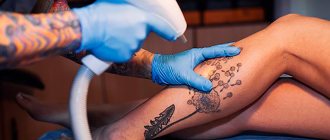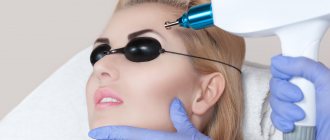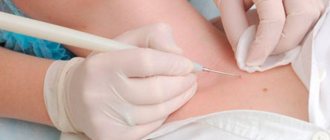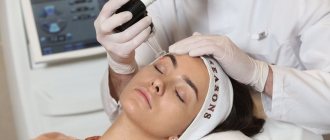Features of laser tattoo removal
Tattoo culture developed gradually.
Today there are 3 general types of skin tattooing on the human body, depending on the purpose:
- Professional drawings. Drawings that are applied under the skin using needles and special equipment. The peculiarity of the work is that pigment paint is fixed at the end of the needle, which is embedded in the upper layer of the skin and remains there for a long time.
- Cosmetic tattoos. This category includes permanent makeup, when the pigment wears off after a few months and requires renewal.
- Medical drawings on the skin of the human body. These are “tattoos” that are applied with safe pigments that indicate the blood type, special information for the upcoming operation, and are erased after some time.
The need to remove a tattoo is most often faced by those who applied the design in a professional way.
The reasons for deletion are most often the following:
- partial abrasion;
- reluctance to see a drawing that reminds of some unpleasant events;
- the need to completely remove the tattoo (for example, this may be due to professional detailing).
Several types of professional equipment are used for laser tattoo removal:
- Ruby laser. This is a device with a rod created on the basis of artificial ruby. The ruby laser works well on black, blue and green pigments. The beam's red range is 694 units. The ruby laser is used to remove tattoos from fair-skinned people. This is due to the fact that melanin actively absorbs the ruby release. When working with a ruby laser, it is necessary to correctly select the beam length. If this is not done, scars will remain on the skin. Ruby laser is strictly prohibited for use if the tattoo has penetrated deeply into the skin. This type of beam is often used for eyebrow tattooing with a penetration depth of up to 1 mm. Ruby is ineffective for blending red, yellow, and orange shades.
- Neodymium laser. The beam removes cold and warm shades. The length of the wave beam for working with neodymium equipment is selected depending on the color of the pigment, while working with a neodymium laser is safer, since there is a limitation on the depth of insertion. The peculiarity of the neodymium laser is the ability of the infrared beam to remove black, dark green, dark blue and yellow-green shades.
- Picosecond laser. The beam destroys the coloring pigment due to photomechanical effects. A picosecond laser is capable of generating a powerful beam and destroying the coloring pigment without damaging the surrounding tissue. The operating technique of a picosecond laser is based on proper selection of beam length and adjustment of equipment with high precision. If everything is done correctly, the effect of a picosecond laser does not leave stretch marks, defects, scars or scars. Working with a picosecond laser is significantly more expensive than removal using other equipment.
- Alexandrite laser. A device with a preset wavelength of 755 units. The beam penetration depth is 1.8 mm. The Alexandrite laser only works to remove dark pigments. The principle of operation is similar to that of a ruby laser. After the first treatment with an alexandrite laser, the tattoo fades significantly, but complete destruction of the design can be achieved only after 5-6 procedures. Alexandrite ray can cause side effects. Blisters, burns, and scars appear on the skin. In addition, the alexandrite laser can cause hypopigmentation.
Neodymium laser device
Laser tattoo removal, reviews of which confirm the effectiveness of the method, is the most modern method. The mechanism of action is based on the splitting of tattoo pigments through exposure to an infrared heat ray.
Experts say that any tattoo can be removed with a laser. Certain problems will arise when removing a pattern made with white pigment. Lasers cannot yet cope 100% with this color due to the peculiarity of the shade. Systematic work on high-quality equipment leads to gradual lightening of the area and the disappearance of traces from the surface of the skin.
There are 2 types of laser beam operation:
- Ablative action. This is a kind of erasing of the pattern, it is often called pilling or laser resurfacing. The mechanism of action is based on removing the top layer of skin simultaneously with the coloring pigment. This method is effective in cases where the pattern is located shallow. Restoration of the upper layer of the epidermis takes 2-3 weeks.
- Selective or selective action. This is a less traumatic removal option, since the laser destroys the coloring pigment without affecting the skin. Selective action means selectivity; in each specific case, specialists select the laser wavelength and its direction.
Similarities and differences in impacts.
| Ablative | Selective |
|
|
The importance of choosing a clinic
This needs to be approached consciously. The difficulty in removing a tattoo is that the specialist will have to work with “material” made by someone else before him. Therefore, he must have mastery in this matter in order to, if possible, assess in advance the extent of the problem and possible risks.
The choice of method for removing the tattoo, and therefore the final result, largely depends on the doctor’s decision. An equally important role is played by the equipment available in the clinic and the conditions in which the procedure will be carried out.
Cost of laser removal
Laser tattoo removal is a fairly expensive procedure. According to reviews, complete mixing costs several tens of thousands of rubles.
Experts prefer to calculate the cost per square centimeter:
- 1 sq. see – from 1200 rub.;
- plot 10x10 cm – from 3000 rub.
Tattoo removal with a picosecond laser
The minimum fixed price for the work is 1200 rubles. for 1 session. To remove marks, it takes from 3 to 5-6 sessions.
When visiting the specialist for the first time, the client is informed of the approximate cost of the procedure. The price may increase if additional difficulties arise during the work.
Pros and cons of using lasers
In addition to laser removal, there are alternative methods.
A brief overview of the techniques allows you to evaluate the advantages of choosing a laser:
- Surgical removal. This is the most traumatic method, which is used only in emergency cases. To remove pigment, dissection of the skin is practiced.
- Chemical bleaching. An alternative to laser exposure, which involves the use of special bleaching ointments. On the one hand, the technique completely eliminates skin injury. On the other hand, it affects all systems of the body, as chemicals enter the blood and spread through the bloodstream.
- Nitrogen treatment. This is a kind of burning, which leads to necrosis of the top layer and further exfoliation. This method is considered relatively inexpensive, but one of the most painful.
Laser removal is a modern and effective technique that is suitable for those who decide to get rid of a tattoo. Possible side effects are associated with a violation of the technique of applying the original design or the use of low-quality coloring pigments. If the tattoo was done in a salon using good equipment, then laser removal in several sessions will lead to the complete disappearance of images from the surface of the skin.
How effective is the procedure?
The final result of laser tattoo removal will depend on the device itself and the quality of the work performed. The neodymium laser is recognized as the most effective. It does an excellent job of removing dyes located at different depths due to the ability to use different wavelengths.
The erbium beam is more focused on removing not very deep tattoos by affecting only the upper layer of the epidermis.
Contraindications to the procedure
The procedure has contraindications. There is a list of possible risks that the client is introduced to before signing consent for manipulation.
It is strictly forbidden to work with a laser if the following conditions exist:
- presence of hematomas on the body;
- development of an infectious disease;
- bleeding of any type;
- the presence of scars and cicatrices;
- presence of allergies;
- blood diseases;
- diseases associated with impaired brain activity;
- various skin diseases: eczema, acne.
Possible complications after the procedure:
- manifestation of hyperpigmentation of the skin;
- changes in skin structure, which may be temporary or permanent;
- darkening of the tattoo;
- change in shade, but not complete disappearance of pigment.
Have questions? Ask:
To summarize: in which areas can a tattoo be easily excised, and in which areas is it quite problematic to do so?
We are often approached by patients who want to remove tattoos located on the back of the foot. Most recently, my patient was a girl with a tattoo of diamonds or squares on this part of her body. Everything was complicated by the fact that the design was literally burned out with a laser, and scars formed on the surface. In such cases, the tattoo, of course, can be excised in narrow strips, but this is not very promising. This area is quite difficult.
The ankle area, the lower third of the leg, is also problematic. But on the lower leg it is already possible to carry out excision without any special difficulties. Only a small tattoo can be excised on the back of the hand, and it is imperative to warn the patient about multi-stage treatment. On the forearm, since there is a small amount of subcutaneous fat in this area, a long, narrow tattoo can be excised. But the areas of the shoulders, back and abdomen are not difficult.
It turns out that areas with a good layer of subcutaneous fat are not a problem? For example, stomach, thighs.
Yes that's right. In these areas, the skin lends itself well to stretching.
Preparation for the procedure
Laser tattoo removal, reviews of which indicate its effectiveness, is a procedure that requires proper preparation. The quality and effectiveness of the result depends on compliance with the requirements.
Typical recommendations:
- For several weeks before visiting a specialist, it is recommended not to use sunscreen and avoid being in direct sunlight.
- You cannot depilate the part of the skin on which the tattoo is applied.
- Do not use exfoliating products, which include peelings and scrubs.
- Smoking is not recommended for several weeks before surgery.
- You should not take anti-inflammatory drugs or folk remedies that affect blood flow.
- A few hours before the procedure, you should drink as much water as possible.
It is impossible to completely remove a tattoo from the skin in one session. Complete discoloration can be achieved only after several sessions and restoration measures.
How to behave before and after
Before the procedure, you must undergo an examination, including a series of tests. It is important to immediately tell your doctor about any existing health problems.
Since there are many ways to remove a tattoo, it is necessary to obtain individual recommendations when discussing how and in how many stages the pigment will be removed. General restrictions that must be followed before the procedure include the following:
- limit exposure to the open sun for several days (hardware procedures do not react very well to a fresh tan);
- If possible, stop taking blood thinning medications;
- Do not drink alcohol or coffee on the day you plan to remove your tattoo.
The same can be said about the rehabilitation period: each case has its own requirements.
During the entire rehabilitation period, it is necessary to protect the treatment site from exposure to sunlight and temperature changes.
How does laser tattoo removal work?
The general scheme for removing pigments from under the skin using a laser is the process of heating microparticles of coloring pigment to a state where they begin to disintegrate. After the particles break down, the paint is washed out naturally through the lymphatic system.
The rate of removal of microparticles depends on additional factors:
- depth of pigment introduction;
- quality of coloring pigment;
- density indicator of the applied pattern;
- localization areas on the body;
- quality of the device;
- professional qualities of a specialist.
The removal process is carried out in several successive stages:
- First, the patient is given safety glasses.
- Then a skin reaction test to the laser is performed.
- Select the appropriate power.
- Skin is treated with laser.
- Then a cooling agent is applied to the treated area and a protective bandage or patch is applied.
In some cases, tattoo removal requires anesthesia to lower the patient's pain threshold. In this case, local anesthetics are used or injections with painkillers are given.
Lightening a tattoo with Cover up
Removing the dye when overcoating is a long process. The paint was applied in layers, filling the skin layer with a large volume of granules. Completing such work may require additional use of brightening agents.
Some sources claim that it is impossible to remove such work. But that's not true. The destruction of paint occurs at the molecular level.
To prevent inflammation from starting from an excess of destroyed granules, special medications are used. A person is prescribed a course of vitamins and sorbents.
The stripping procedure is divided into stages. Not the entire area is cleared, but square by square. A difference from a tattoo with a single-layer design may be a change in the pigmentation of the skin area.
If the previous drawing was closed using the blackwork technique, the consequence will be yellowed skin with a visible outline of the previous work.
Recovery period
Laser tattoo removal, which has numerous reviews, requires careful attention to the recovery period. In most cases, you can immediately return to normal life after the procedure.
But during the time when the skin is actively recovering, it is necessary to follow general recommendations:
- You cannot steam your skin for 14 days after the procedure;
- visiting baths, saunas or swimming pools is completely excluded;
- It is strictly forbidden to sunbathe or visit a solarium (such steps lead to injury and scarring).
If we are talking about removing a tattoo or tattoo on the face, then you should not use decorative cosmetics for several days in a row. For the body, avoid using alcohol-based products completely. It is also better to completely eliminate the possibility of exposing the treated area to hot water, rough clothing or synthetic dressings. It is necessary to avoid contact of injured skin with chemicals.
No special care is required for the removal area unless necessary. Experts recommend using a healing agent if the removal did not go as expected. You should not use special means to remove the resulting swelling. If everything is done correctly, the swelling will go away on its own in a few hours or a few days.
How long does rehabilitation last?
Tattoo removal cannot be called a simple and quick procedure. In most cases, it takes months for the skin to clear of pigment and heal completely. In addition, if the tattoo was very large and the pigment penetrated deep into the skin, a procedure may be necessary to remove or smooth out the scars formed during its removal.
Therefore, you immediately need to be prepared for the fact that in order to obtain the final result (i.e., completely getting rid of the tattoo or at least its maximum camouflage), several sessions may be required, and each time you will have to deal with such phenomena as:
- severe skin redness and swelling;
- the appearance of a crust or wound that requires special care;
- pain and itching are possible as the tissue heals - in this case, you need to consult a doctor who will prescribe a medication, but in no case use the recommendations of friends and relatives.
It is very important to prevent skin infection and inflammation at this time.
How painful is tattoo removal?
Laser tattoo removal causes pain and discomfort. 90% of patients compare the sensations after tattoo removal with the sensations that arise during the process of applying it.
The following factors play a special role:
- tattoo location area;
- pain threshold, which is individual for each person.
The most dangerous and sensitive areas are those located near large veins. The sensitive areas of the upper body are the least sensitive. The most painful places to remove designs are from the wrist, palms, face, upper back, and neck. To determine the sensitivity of the area, the rule works: the larger the fat deposits under the skin, the less painful the effect.
Possible complications and contraindications
There are some contraindications, the presence of which will make laser removal impossible:
- Epilepsy.
- Colds and chronic aggravated diseases.
- Fresh tan.
- Pregnancy and lactation period.
- Cancer diseases.
- Blood clotting problems.
- The presence of inflammation and wounds on the skin.
- Tendency to scar healing.
What can influence the effect
Laser tattoo removal, reviews of which speak of effectiveness, is actually not always effective. It depends on related factors.
Laser tattoo removal with alexandrite laser
The effectiveness of the chosen method can be influenced by the following properties:
- Applying drawings using an artisanal method. In this case, the quality of the pigment dye turns out to be very low; non-professional equipment is most often used to introduce it under the skin, so the dye is unevenly located under the skin. This means that removal requires adjustment of different wavelengths.
- An overabundance of yellow and orange shades. It’s quite difficult to create a warm color palette. Pigments of yellow, orange and red are “stubborn” paints, as experts call them. For their information, a neodymium laser is recommended. In addition, green tones may turn pink or fade unevenly when exposed to rays. White paint under the influence of a laser beam acquires a greenish tint.
- Tattoo style. For removal, the tattoo technique is of great importance. If a person removes a tattoo with shading, then it takes less time than to remove a design with a clearly defined outline.
Basic rules for tattoo removal - factors influencing effectiveness
All tattoos can be removed one way or another. The only question is how successfully the tattoo will be removed and what consequences this process will entail.
There are several factors that influence the success of a tattoo:
- Tattoo age.
- Color of the skin.
- Tattoo location.
- Tattoo color.
- The human body's ability to regenerate.
The easiest way to remove tattoos is for people with fair skin. Tattoos are best removed on places such as the arms, legs, chest and buttocks. The easiest way would be to remove a fresh tattoo. By the way, you can also remove unsuccessfully performed eyebrow tattoos.
The complexity of the process also depends on the human body’s ability to regenerate and the color of the tattoo. The easiest way to create a monochromatic design is black, red, purple and dark blue.
Accordingly, a multi-colored old tattoo on dark skin will be difficult to remove.
How many sessions are required for permanent tattoo removal?
The duration of one session lasts approximately 20-30 minutes. To treat a skin area with a total area of 10x10 cm and completely remove a small tattoo, 3-5 sessions will most often be required. Please note that the recommended recovery and rest periods must be observed between sessions. The rehabilitation course is at least 1-1.5 months.
The wizard sees how many sessions will be required only after the start of work. In some cases, if the pigment quickly deteriorates, the number of sessions can be reduced to 2. Removing large tattoos that cover different areas of the body takes 8-12 months, taking into account rest periods between sessions.
Laser tattoo removal is a modern and effective method. To completely get rid of a tattoo, you should choose the correct method of reduction. According to customer reviews, the main importance is the skill and professional qualities of the specialist who carries out the work, as well as the ability of the patient’s skin to actively recover.
In what situations is a tattoo removed?
tattoo removal are endless, but most of them can be boiled down to a few points:
- The relationship with the person who inspired the tattoo has changed. The name or portrait of a girl (boyfriend) tattooed on the body after a breakup is a soul-hurting memory that you want to get rid of.
- When the figure changes , the drawing is seriously distorted. A previously inspiring pattern turns into an annoying caricature.
- Nowadays they are loyal to tattoos on the bodies of young people and in most cases this is not an obstacle to hiring. But this does not always happen and not everywhere. If a coveted high-paying job is at stake, the tattoo is removed.
- When the original drawing was poorly executed or deteriorated as a result of improper care during the healing process, it is also discarded.
- Gone is teenage maximalism.
- At an older age, there is often a desire to remove a tattoo done “for company”, which has begun to look ridiculous on the body of a respectable person.
- Some phrases that came from ancient tribes look ridiculous in the modern world. When a person learns the true meaning of the hieroglyphs written on his body, it is natural to want to get rid of them.











